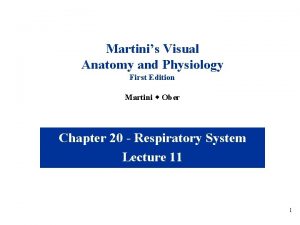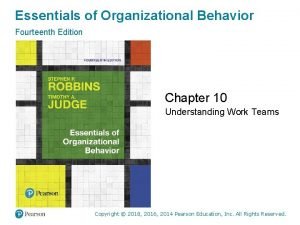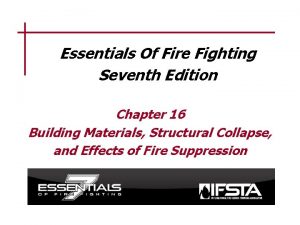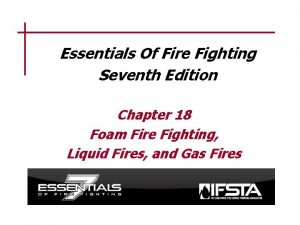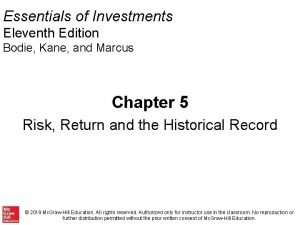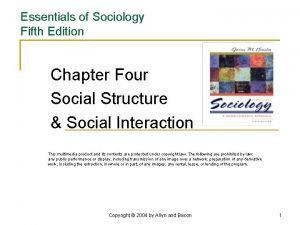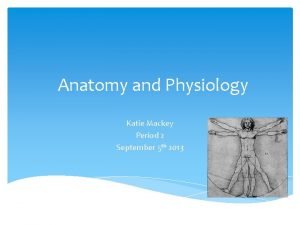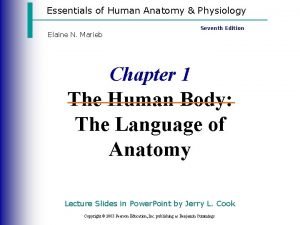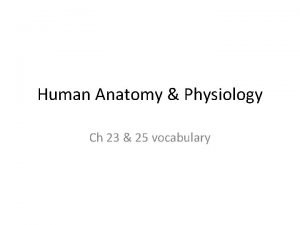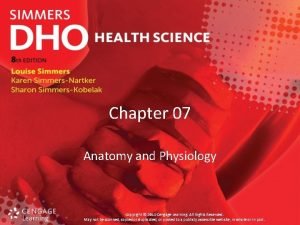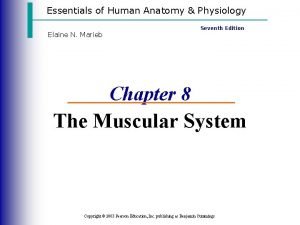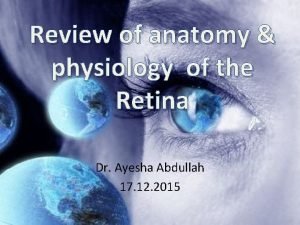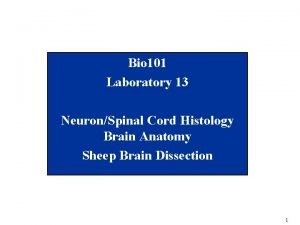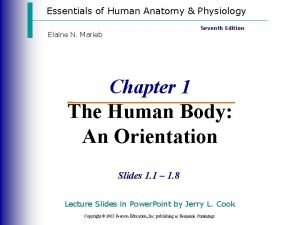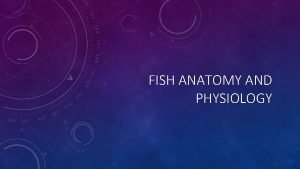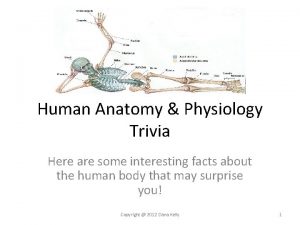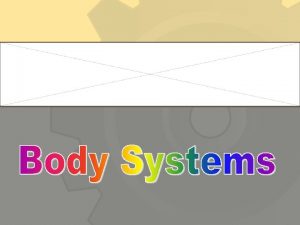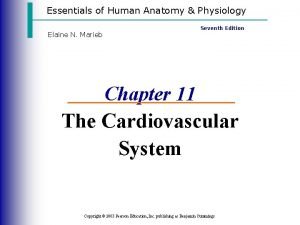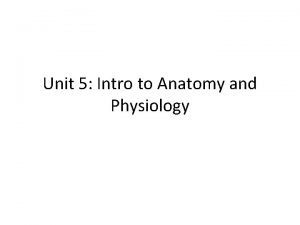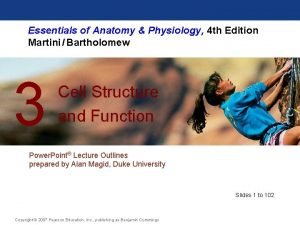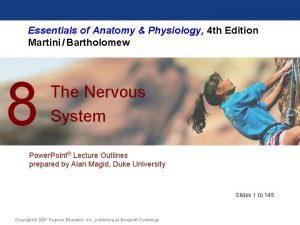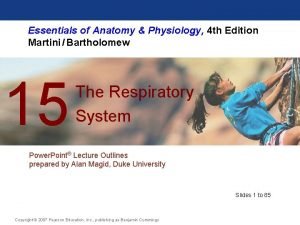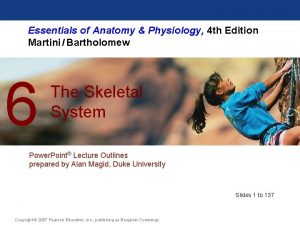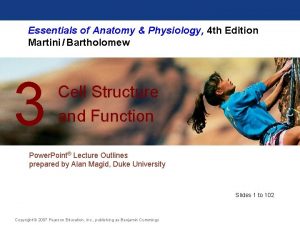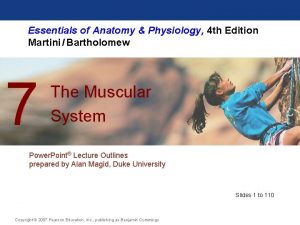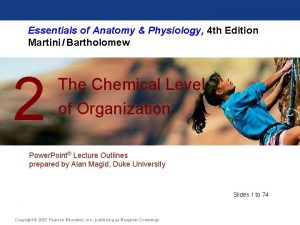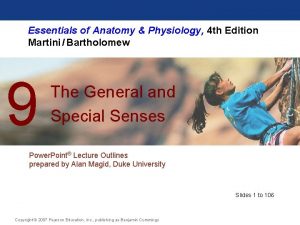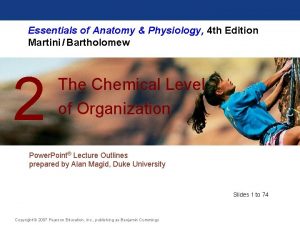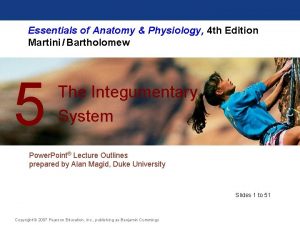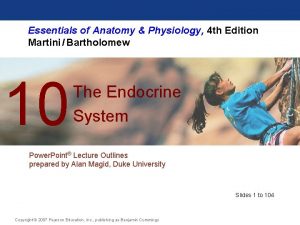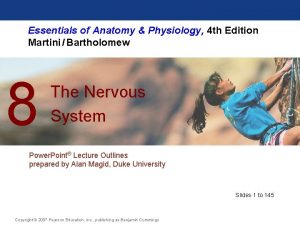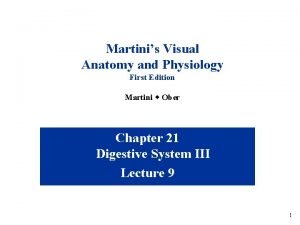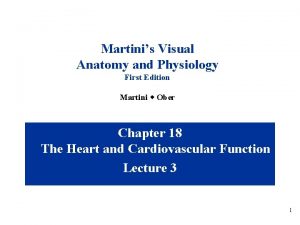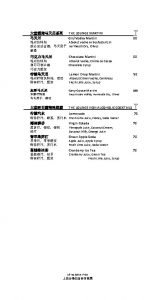Essentials of Anatomy Physiology 4 th Edition Martini






















































- Slides: 54

Essentials of Anatomy & Physiology, 4 th Edition Martini / Bartholomew 11 The Cardiovascular System: Blood Power. Point® Lecture Outlines prepared by Alan Magid, Duke University Slides 1 to 54 Copyright © 2007 Pearson Education, Inc. , publishing as Benjamin Cummings

The Functions of Blood Cardiovascular System Overview • Provides a system for rapid transport within the body • Nutrients • Hormones • Waste products • Respiratory gases • Cells • Heat Copyright © 2007 Pearson Education, Inc. , publishing as Benjamin Cummings

The Functions of Blood functions include: • Transport of cells and compounds • Regulate p. H and electrolytes of interstitial fluids • Limit blood loss through damaged vessels • Defend against pathogens, toxins • Absorb, distribute heat as part of temperature regulation Copyright © 2007 Pearson Education, Inc. , publishing as Benjamin Cummings

The Composition of Blood Collection and Analysis • Whole blood can be fractionated into: • Plasma (liquid component) • Formed elements (cellular components) • Red blood cells (RBCs) • White blood cells (WBCs) • Platelets Copyright © 2007 Pearson Education, Inc. , publishing as Benjamin Cummings

The Composition of Blood The Composition of Whole Blood Figure 11 -1(a)

Plasma Basics • Makes up about 55% of whole blood • Water makes up about 92% of plasma • Has more protein and oxygen than interstitial fluid • Plasma proteins fall in three classes • Albumins • Globulins • Fibrinogen Copyright © 2007 Pearson Education, Inc. , publishing as Benjamin Cummings

Plasma Key Note Approximately half the volume of whole blood consists of cells and cell products (the formed elements). Plasma resembles interstitial fluid but contains a unique mixture of proteins not found in other extracellular fluids. Copyright © 2007 Pearson Education, Inc. , publishing as Benjamin Cummings

Plasma The Composition of Whole Blood Figure 11 -1(b)

Formed Elements Hemopoiesis—The cellular pathways by which the formed elements are produced. Stem cells (hemocytoblasts)—Cells that divide and mature to produce all three classes of formed elements. Copyright © 2007 Pearson Education, Inc. , publishing as Benjamin Cummings

Formed Elements Red Blood Cells • Also called, erythrocytes or RBCs • Make up about 45% of whole blood volume • Make up 99. 9% of the formed elements Copyright © 2007 Pearson Education, Inc. , publishing as Benjamin Cummings

Formed Elements Hematocrit—Percentage of whole blood volume taken up by formed elements (mostly RBCs). In clinical shorthand, it’s called, the “crit. ” Copyright © 2007 Pearson Education, Inc. , publishing as Benjamin Cummings

Formed Elements The Composition of Whole Blood Figure 11 -1(c)

Formed Elements Properties of RBCs • Transport oxygen and carbon dioxide in blood stream • Have large surface to volume ratio • Speeds up gas loading/unloading • Lack most organelles • Makes more room for hemoglobin • Degenerate after about 120 days Copyright © 2007 Pearson Education, Inc. , publishing as Benjamin Cummings

Formed Elements The Anatomy of Red Blood Cells Figure 11 -2

Formed Elements Red Blood Cell Composition • Hemoglobin makes up 95% of RBC protein • Globular protein composed of four subunits • Each subunit contains: • A globin protein chain • A molecule of heme • An atom of iron • A binding site for one oxygen molecule • Phagocytes recycle hemoglobin from damaged or dead RBCs Copyright © 2007 Pearson Education, Inc. , publishing as Benjamin Cummings

Formed Elements Hemoglobin Recycling Figure 11 -4

Formed Elements Erythropoiesis—Process formation of red blood cells • Occurs mainly in the bone marrow • Stimulated by erythropoietin (EPO) • EPO increases when oxygen levels are low • Development stages include: • Erythroblasts • Reticulocytes (after nucleus is expelled) Copyright © 2007 Pearson Education, Inc. , publishing as Benjamin Cummings

Formed Elements The Origins and Differentiation of RBCs, Platelets, and WBCs Figure 11 -5 PLAY Origins and Differentiation of Formed Elements

Bone marrow Release of erythropoietin (EPO) Tissue oxygen levels decline Stem cells Increased mitotic rate Accelerated Erythroblasts maturation Reticulocytes Tissue oxygen levels rise Improved oxygen content of blood Increased numbers of circulating RBCs Copyright © 2007 Pearson Education, Inc. , publishing as Benjamin Cummings Figure 11 -6 1 of 7

Tissue oxygen levels decline Copyright © 2007 Pearson Education, Inc. , publishing as Benjamin Cummings Figure 11 -6 2 of 7

Release of erythropoietin (EPO) Tissue oxygen levels decline Copyright © 2007 Pearson Education, Inc. , publishing as Benjamin Cummings Figure 11 -6 3 of 7

Bone marrow Release of erythropoietin (EPO) Stem cells Increased mitotic rate Tissue oxygen levels decline Copyright © 2007 Pearson Education, Inc. , publishing as Benjamin Cummings Erythroblasts Figure 11 -6 4 of 7

Bone marrow Release of erythropoietin (EPO) Tissue oxygen levels decline Stem cells Increased mitotic rate Accelerated Erythroblasts maturation Reticulocytes Copyright © 2007 Pearson Education, Inc. , publishing as Benjamin Cummings Figure 11 -6 5 of 7

Bone marrow Release of erythropoietin (EPO) Tissue oxygen levels decline Stem cells Increased mitotic rate Accelerated Erythroblasts maturation Reticulocytes Increased numbers of circulating RBCs Copyright © 2007 Pearson Education, Inc. , publishing as Benjamin Cummings Figure 11 -6 6 of 7

Bone marrow Release of erythropoietin (EPO) Tissue oxygen levels decline Stem cells Increased mitotic rate Accelerated Erythroblasts maturation Reticulocytes Tissue oxygen levels rise Improved oxygen content of blood Increased numbers of circulating RBCs Copyright © 2007 Pearson Education, Inc. , publishing as Benjamin Cummings Figure 11 -6 7 of 7

Formed Elements Key Note Red blood cells (RBCs) are the most numerous cells in the body. They circulate for about four months before being recycled; millions are produced each second. The hemoglobin inside transports oxygen from the lungs to peripheral tissues and carbon dioxide from the tissues to the lungs. Copyright © 2007 Pearson Education, Inc. , publishing as Benjamin Cummings

Formed Elements Blood Type • Determined by presence or absence of specific antigens (agglutinogens) on outside surface of RBC • Antigens are called A, B, and Rh • Antibodies (agglutinins) in plasma react with foreign antigens on RBCs • RBCs clump and break open • Anti-Rh antibody made after exposure to Rh-positive blood cells Copyright © 2007 Pearson Education, Inc. , publishing as Benjamin Cummings

Formed Elements Blood Types and Cross-Reactions Figure 11 -7(a)

+ Surface antigens + Opposing antibodies Copyright © 2007 Pearson Education, Inc. , publishing as Benjamin Cummings Agglutination (clumping) and hemolysis Figure 11 -7(b) 1 of 5

Surface antigens Copyright © 2007 Pearson Education, Inc. , publishing as Benjamin Cummings Figure 11 -7(b) 2 of 5

+ Surface antigens + Opposing antibodies Copyright © 2007 Pearson Education, Inc. , publishing as Benjamin Cummings Figure 11 -7(b) 3 of 5

+ Surface antigens + Opposing antibodies Copyright © 2007 Pearson Education, Inc. , publishing as Benjamin Cummings Agglutination (clumping) Figure 11 -7(b) 4 of 5

+ Surface antigens + Opposing antibodies Copyright © 2007 Pearson Education, Inc. , publishing as Benjamin Cummings Agglutination (clumping) and hemolysis Figure 11 -7(b) 5 of 5

Formed Elements White Blood Cells (WBCs) • Also called, leukocytes • Defend the body against: • Pathogens • Toxins • Abnormal cells • Damaged cells Copyright © 2007 Pearson Education, Inc. , publishing as Benjamin Cummings

Formed Elements WBC Properties • Perform diapedesis—Push between cells to cross blood vessel walls and enter the tissues • Exhibit chemotaxis—Move toward specific chemicals released by bacteria or injured cells • Consist of two groups: • Granulocytes (cytoplasmic granules) • Agranulocytes (no granules) Copyright © 2007 Pearson Education, Inc. , publishing as Benjamin Cummings

Formed Elements Three Types of Granulocytes • Neutrophils • 50– 70% of circulating WBCs • Phagocytic • Eosinophils • Less common • Phagocytic • Attracted to foreign proteins • Basophils • Release histamine • Promote inflammation Copyright © 2007 Pearson Education, Inc. , publishing as Benjamin Cummings

Formed Elements Two Types of Agranulocytes • Lymphocytes • Found mostly in lymphatic system • Provide specific defenses • Attack foreign cells • Produce antibodies • Destroy abnormal (cancer) cells • Monocytes • Migrate into tissues • Become macrophages • Live as phagocytic amoeba Copyright © 2007 Pearson Education, Inc. , publishing as Benjamin Cummings

Formed Elements White Blood Cells Figure 11 -8(a)

Formed Elements White Blood Cells Figure 11 -8(b)

Formed Elements White Blood Cells Figure 11 -8(c)

Formed Elements White Blood Cells Figure 11 -8(d)

Formed Elements White Blood Cells Figure 11 -8(e)

Formed Elements Production of WBCs in Bone Marrow • Myeloid stem cells produce: • Granulocytes (three types) • Monocytes (future macrophages) • Lymphoid stem cells produce lymphocytes • Process called, lymphopoiesis • Lymphocytes enter blood • Migrate to lymphoid tissues Copyright © 2007 Pearson Education, Inc. , publishing as Benjamin Cummings

Formed Elements Regulation of WBC Maturation • Colony-stimulating factors (CSFs)— Hormones which regulate certain WBC populations • Four CSFs are known • CSFs target stem cell lines • Several CSFs used with cancer patients with bone marrow suppression Copyright © 2007 Pearson Education, Inc. , publishing as Benjamin Cummings

Formed Elements Regulation of WBC Maturation • Regulation of lymphocyte maturation is poorly understood • Thymosins (hormones in thymus gland) trigger T cells to develop Copyright © 2007 Pearson Education, Inc. , publishing as Benjamin Cummings

Formed Elements Key Note WBCs outnumber RBCs by a 1000 to 1. WBCs defend the body against infection, foreign cells, or toxins, and assist in the repair of damaged tissues. Most numerous are neutrophils, which engulf bacteria, and lymphocytes, which are responsible for the specific immune defenses. Copyright © 2007 Pearson Education, Inc. , publishing as Benjamin Cummings

Platelets are • Produced in the bone marrow • Released from megakaryocytes as cytoplasmic fragments into the blood • Essential to clotting process Copyright © 2007 Pearson Education, Inc. , publishing as Benjamin Cummings

Hemostasis—Processes that stop the loss of blood from a damaged vessel. Largely dependent on platelets and soluble proteins (clotting factors). Copyright © 2007 Pearson Education, Inc. , publishing as Benjamin Cummings

Hemostasis Three phases in Hemostasis: • Vascular phase • Local contraction of injured vessel • Platelet phase • Platelets stick to damaged vessel wall • Coagulation phase • Clotting factors in plasma form blood clot Copyright © 2007 Pearson Education, Inc. , publishing as Benjamin Cummings

Hemostasis The Clotting Process • Coagulation pathways require an external trigger • Extrinsic pathway • Triggered by factors released by injured endothelial cells or peripheral tissues • Intrinsic pathway • Triggered by factors released by platelets stuck to vessel wall • Both pathways lead to common pathway • Thrombin converts soluble fibrinogen subunits to an insoluble polymer, fibrin Copyright © 2007 Pearson Education, Inc. , publishing as Benjamin Cummings

Hemostasis The Structure of a Blood Clot Figure 11 -9

Hemostasis Events in the Coagulation Phase of Hemostasis Figure 11 -10

Hemostasis Clot Retraction and Removal • Clot retracts because platelets contract • Pulls broken vessel closed • Clot gradually dissolves • Called, fibrinolysis • Plasmin, an enzyme derived from plasminogen in the plasma, cuts fibrin apart like a molecular scissors Copyright © 2007 Pearson Education, Inc. , publishing as Benjamin Cummings

Hemostasis Key Note Platelets coordinate hemostasis (blood clotting). If they are activated by abnormal changes in their surroundings, platelets release clotting factors and other chemicals. Hemostasis is a complex cascade that produces a fibrous patch that is subsequently remodeled and then removed as repair proceeds. Copyright © 2007 Pearson Education, Inc. , publishing as Benjamin Cummings
 Paratubular cyst
Paratubular cyst Human anatomy and physiology seventh edition marieb
Human anatomy and physiology seventh edition marieb Anatomy and physiology ninth edition
Anatomy and physiology ninth edition Tree in lung real photo
Tree in lung real photo Types of group
Types of group Business essentials 12th edition
Business essentials 12th edition Firefighter essentials 7th edition
Firefighter essentials 7th edition At a bulk transport incident firefighters must
At a bulk transport incident firefighters must Essentials of investments 11th edition
Essentials of investments 11th edition Business essentials 12th edition
Business essentials 12th edition Criminal justice the essentials 5th edition
Criminal justice the essentials 5th edition Cryptographic systems are generically classified by
Cryptographic systems are generically classified by Business essentials 12th edition answer key
Business essentials 12th edition answer key The time/space collaboration and social tool matrix
The time/space collaboration and social tool matrix Network security essentials 5th edition pdf
Network security essentials 5th edition pdf Essentials of sociology 5th edition
Essentials of sociology 5th edition Physiology of sport and exercise 5th edition
Physiology of sport and exercise 5th edition Holes essential of human anatomy and physiology
Holes essential of human anatomy and physiology Jeopardy anatomy and physiology game
Jeopardy anatomy and physiology game Respiratory system of human
Respiratory system of human Irn.org anatomy and physiology
Irn.org anatomy and physiology Chapter 7:9 lymphatic system
Chapter 7:9 lymphatic system Anatomy and physiology
Anatomy and physiology Anatomy and physiology
Anatomy and physiology Anatomy and physiology chapter 8 special senses
Anatomy and physiology chapter 8 special senses Anatomy and physiology vocabulary
Anatomy and physiology vocabulary Cengage anatomy and physiology
Cengage anatomy and physiology Difference between anatomy and physiology
Difference between anatomy and physiology Anatomy and physiology
Anatomy and physiology Lower respiratory structures
Lower respiratory structures Medial lateral distal proximal
Medial lateral distal proximal Anatomy and physiology of the retina
Anatomy and physiology of the retina Cornell notes for anatomy and physiology
Cornell notes for anatomy and physiology Sheep brain
Sheep brain Anatomy and physiology chapter 2
Anatomy and physiology chapter 2 Http://anatomy and physiology
Http://anatomy and physiology Aohs foundations of anatomy and physiology 1
Aohs foundations of anatomy and physiology 1 Body landmarks diagram
Body landmarks diagram Fish anatomy and physiology
Fish anatomy and physiology Anatomy and physiology bone
Anatomy and physiology bone Human physiology exam 1
Human physiology exam 1 Integumentary system psoriasis
Integumentary system psoriasis Anatomy and physiology trivia
Anatomy and physiology trivia Anatomy and physiology unit 7 cardiovascular system
Anatomy and physiology unit 7 cardiovascular system Art labeling activity: figure 14.1 (3 of 3)
Art labeling activity: figure 14.1 (3 of 3) Aohs foundations of anatomy and physiology 1
Aohs foundations of anatomy and physiology 1 Anatomy and physiology body parts
Anatomy and physiology body parts Chapter 13 anatomy and physiology of pregnancy
Chapter 13 anatomy and physiology of pregnancy Anatomy and physiology
Anatomy and physiology Anatomy and physiology
Anatomy and physiology Anatomy and physiology
Anatomy and physiology Epigastric vs hypogastric
Epigastric vs hypogastric Anatomical position
Anatomical position Tattoo anatomy and physiology
Tattoo anatomy and physiology Aohs foundations of anatomy and physiology 1
Aohs foundations of anatomy and physiology 1



